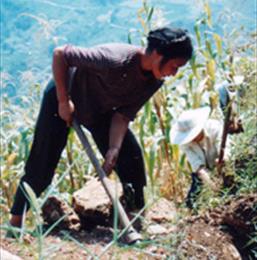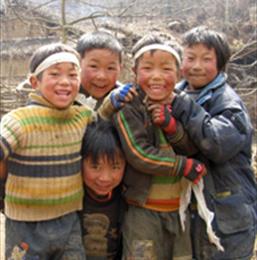Banyang Village, 1997-2001
About halfway along the road from Hanyuan County town to Wusihe train station in the south of the County, is Banyang Village. Banyang is a collection of 9 hamlets scattered along the hillsides of the Dadu River valley. The hamlets are spread out along a 10 km stretch of the road. Hamlets 1,2,3,6,7,8 are near the road and hamlets 4,5 and 9 are 1-3 hours walk up the hillside. The population of the village was reported as 940 in 234 households in 1997. Hamlets 1,4 and 5 had no electricity, the others are all connected to the mains supply. The hamlets along the road are very short of land, with only a small amount of irrigated land, at hamlet 3. Fields are on slopes sometimes in excess of 25 degrees. The main crops are maize, sweet potatoes, rice, wheat, chestnuts, walnuts and beans. Livestock include pigs, cattle (for ploughing) and horses (at hamlets 4, 5 and 9) for transport. Goats are grazed on the steep slopes unsuitable for arable farming. Hamlet 1 and 2 are populated by Han people, whilst the inhabitants of all the other hamlets are of the Yi ethnic group (see the research report for a more detailed look at a Yi village). The village houses are made of mud brick with tiled roofs.
DORS is supporting a water supply project at hamlet No. 8, a women's rural credit scheme throughout the whole village (hamlets 1-9), a micro hydropower project in Hamlet 4, an electricity connection project in hamlet 1, rebuilding of the school at hamlet 5 and assisting schoolchildren throughout the village through our Education Project.
Banyang Village Hamlet 8 Drinking and Irrigation Water Supply Project
The hamlet is a cluster of 32 mud-brick houses with tiled roofs sitting on a steep hillside. Rocks protrude between the houses and the village paths wind between them. Most of the village farm land is alongside and above the village houses. There is a very small stream water source piped to the village from 2.5 km away although this source is not adequate for household needs and dries up in winter. Previously only one season of crops could be grown each year. The soil is very dry, thin and stony. Rice, the people's preferred grain crop will not grow in such conditions without irrigation. Wheat, which can be grown as a winter crop, also requires a higher soil moisture content. The villager's income would significantly increase if they were able to grow two seasons of crops.
Our project in Banyang aims to solve both the drinking and irrigation water problems faced by this village.
As there is no suitable water source in the village, and the Dadu River is too fast and furious to consider pumping, the only feasible source is one located on the hillside on the opposite bank of the Dadu.
A small cement channel has been constructed on the far side of the valley to carry the water from the mountain stream source to a point directly opposite the village. From there, a steel suspension wire holds two plastic pipes in suspension across the 800 metre span. The water is then stored in a drinking water tank and a separate tank for irrigation water. From these tanks smaller channels will allow water to run between terraced fields for growing rice in the summer and wheat in the winter. The villagers provide the labour and organise the construction work to fit in with their already busy agricultural work. DORS bought the required construction materials.
Banyang hamlet 8 is an exclusively Yi village. The Yi have their own language and way of life distinct from the Han Chinese.
One particular custom of the Yi people is drinking home-brewed sorghum wine (gaoliang jiu). This is fermented in large earthenware jars and is drunk directly from the jar using a long bamboo straw. The drinking etiquette involves each person drinking a measure defined by a small stick which is placed across the neck of the jar. Another smaller stick pierces this first one at rigt angles and dips down into the wine. When the level of the wine falls below the tipl of this stick, the drinker has finished their measure. The jar is then refilled with water and the next person is invited to drink. When a guest arrives in the village, it is customary to give them a drink or two!
The project was able to proceed in April 1997 after DORS received 65,000 RMB from the British Chamber of Commerce in China - the project sponsors, and the final stage - the irrigation channels to the fields - is now close to completion.
To follow the progress of this project see our monthly newsletters. To see some of our photos of Banyang Village and the project go to the Photo Gallery. Also, during our work on each project we carry out a detailed baseline study of each village, this can be see at: Banyang Village Baseline Study.
Banyang Village Women's Rural Credit Scheme
Implementation of Scheme
DORS Rural Credit Scheme in Banyang Village began in May 1998 in hamlets 2,3,4 and 5. Loans were made in hamlets 1,6,7,8,and 9 in November and December 1998. A meeting was held in hamlet 3, which is located next to the road, for both the women there and also those from the more remote hamlets 4 and 5, explaining the scheme and discussing with the women their preferred method of repayment. As in the project in Sugu Village the women organised themselves into small groups of five, although at Banyang they chose to repay their loans every six months rather than monthly. The township Women’s Cadre assisted with the project. A few weeks later the scheme was extended to women in hamlet 2, who had heard about the project from friends and relatives in the other hamlets.
In November 1998 a meeting was held with women from hamlet 6. They organised themselves into groups of five and took loans to a maximum 1000 RMB with a repayment schedule of six months, a schedule they decided upon themselves. In hamlet 7 a similar procedure was followed. Later, loans were also made to women from hamlet 8 and hamlet 9. Uptake rate in these 4 hamlets was very high, with 80 - 90% of all village women participating in the scheme. The majority wanted loans for livestock rearing, although several were opening small shops on the road. A new factory is under construction which has provided trade for a few general shops. Repayments will be made by sale of livestock (hamlets 8 and 9), from wages from temporary labouring jobs (hamlet 6) and various other trades (shop-keeping and transportation). No loans were made to men. If men accompanied their wives we were sure to direct our questions to the women and listen to their answers rather than their husbands. It was made clear to all the women that the project on which the loan was to be spent must be their own choice, that they have the responsibility for repaying the loans, and that the project is to help them improve their household income through their own efforts.
In 1998 a total of 162 women in Banyang Village received rural credit loans from DORS.
In 1999 and early 2000 loans were made a second time to women from hamlets 1,2,3,7 and 9. Loans were for one year, with two repayments at six monthly intervals. However, after discussing the benefits of the scheme with the women some specific requests were made to amend the scheme. Hamlet 1 took loans of over 1000 RMB (up to 3000 RMB)as some of the women wanted to engage in trade, and hamlet 5 asked for a longer repayment timetable of one and a half years. A total of 73 women took loans, disbursing a cash total of 65,100 RMB (GBP5000). As the repayments in hamlets 6 and 8 were not made on time and there were still some outstanding, these hamlets were not offered a second loan at this time.
The funding for this project has come from the British Chamber of Commerce in China, The Trace Foundation (USA) and Misereor or Germany.
Banyang Village Hamlet 4 Micro Hydropower Project
In response to a request for assistance DORS agreed to help this remote hamlet in the design and purchase of materials for a small 1.5 kW hydropower generator to supply domestic electricity to six of the hamlet's nine households (the remaining 3 households are located more than 1km away from the generator meaning wiring would be unable to carry such low voltage electricity to these homes). The water source used was a mountain stream behind the hamlet. Part of this water is now channelled into a masonry water collection tank then piped down a hillside into the small building housing the generator where it passes through the turbine providing power.
This project was completed in March 1999.
Banyang 5 School Rebuilding Project
The former two-room mud-brick school building was in poor repair. The small windows let in little light, barely enough for the children to see. The rooms were cold as there was no glass in the windows and the doors were left open to let in the light. The people of this hamlet high in the mountains could not raise the funds needed to repair the school themselves, managing only to secure a few replacement tiles for the roof from the local township government. To prevent the school falling into such a state of disrepair that it would eventually have to be closed, and thus take away these children’s only access to education, the villagers sought out DORS’ assistance. We agreed to pay for the materials and contribute to the cost of transporting the cement, sand and other materials the three hour climb up the track from the nearest road.
The new school building is a great improvement on the previous one, although still a simple design. There are three rooms (two classrooms and a teachers' office), glazed windows , a concrete floor and whitewashed walls. The school teacher Mr Li managed the project and the finances and completed the school in a few months with the help of the men and women from his hamlet. The total cost was 1000 GBP.
British Embassy Small Grants Scheme provided the funds for this project
Banyang 1 Electricity Supply Project
Liu Jinlan, a village woman, was chosen by the people of this hamlet to work with DORS to implement a electricity supply project in Banyang Hamlet 1. Discussions went on for some time as to whether to install a hydro-power generator, or to connect to the grid. DORS invited local experts from the Electricity Supply Department and the Agricultural Machinery Department to assess the project. There were advantages and disadvantages to both ideas. In the end it was decided to connect to the grid connection. DORS provided part of the funding and the villagers contributed 700 RMB per household as well as the labour and liasing with the various departments involved.
The connection project was completed in early 2000.
Assisting Schoolchildren - DORS Education Project
As part of our integrated approach to tackling the problems in Hanyuan's villages, we provide short-term assistance to children from our project villages who do not have the opportunity to attend primary school because their families can not afford the mere 200-250 RMB fees. We expect that through our other projects in a particular village, such as the irrigation and women's rural credit schemes in Banyang, lasting improvements will be achieved, and in time, families will be in a position where they can afford to pay their children's school fees themselves. However due to the poverty that presently exists in many of the villages where we have projects, many children are forced to drop out of school. DORS provides support to the poorest children in our project villages by paying their school fees.
DORS have been providing education assistance to children in Banyang since Feb. 1997. To read more about our support of students please visit our Education Project page.


